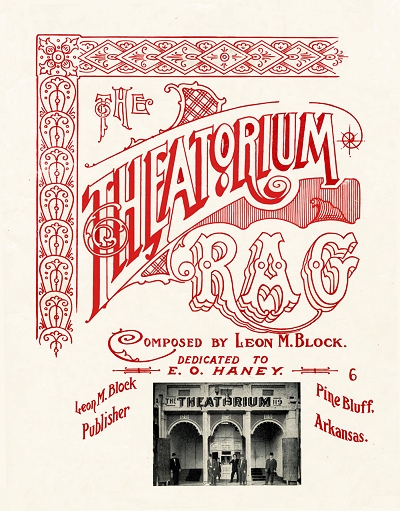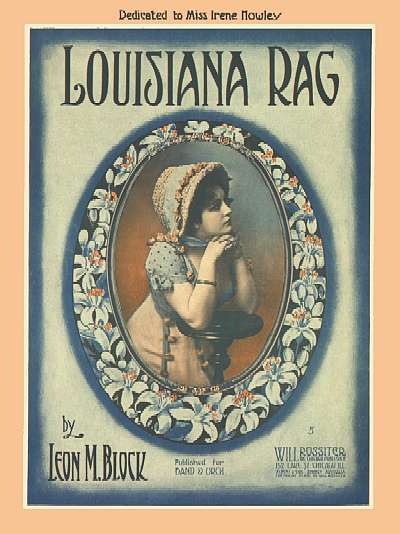|
Leon Meier Block (November 21, 1885 to May, 1969) | |
 Known Compositions Known Compositions | |
|
1907
Madras Rag1909
Theatorium Rag1911
Louisiana Rag1912
I'd Love to Live in Loveland with a Girl LikeYou (Waltzes)[1,2] 1913
That Hypnotic Rag1923
Pal of my Dreams [3]You Can't Two-Time Daddy and Make a Get-a-way [3] |
1924
Memories of Yesterday [3]Dream Pal [3] 1928
No One [4]Wondering Who [4] 1929
Wonderful Days [4]My Own Wee Heaven [5]
1. w/W.R. Williams (Will Rossiter)
2. w/Harry L. Alford 3. w/Leonard G. Harris 4. w/Ohren Smulian 5. w/Imogene Tolleson Payne |
Leon M. Block did not leave much behind for us to learn about him. His Louisiana Rag remains fairly well known in the ragtime community a century after its composition, but details on Block himself have never been reported. What little was located is presented here. He was born to Bavarian immigrant Louis Block and his Illinois native wife Henrietta "Hattie" Cook (possibly Harriet) in New Madrid, Missouri. They had married in St. Louis, Missouri, in 1867. Leon had two older siblings, Rosena L. (2/1868) and Jacob S. (6/20/1872). As of the 1880 enumeration Louis was listed as a retail merchant in New Madrid. By 1900 he had become a farmer, still based in New Madrid. Jacob was a salesman by this time, and Leon was still in school.
As of the 1880 enumeration Louis was listed as a retail merchant in New Madrid. By 1900 he had become a farmer, still based in New Madrid. Jacob was a salesman by this time, and Leon was still in school.
 As of the 1880 enumeration Louis was listed as a retail merchant in New Madrid. By 1900 he had become a farmer, still based in New Madrid. Jacob was a salesman by this time, and Leon was still in school.
As of the 1880 enumeration Louis was listed as a retail merchant in New Madrid. By 1900 he had become a farmer, still based in New Madrid. Jacob was a salesman by this time, and Leon was still in school.Nothing is known about Leon's musical education. However, he was listed in various locations as a working musician by 1906. A July 1907 mention in the Weekly Record of New Madrid touted him as the musical director of a play, The Parisian Princess, at the local opera house, which included an unpublished work, Madras Rag. His first self-published composition, Theatorium Rag, was released in 1909, initially issued from Pine Bluff, Arkansas, but possibly printed in St. Louis. The cover features a photograph of the Theatorium in Pine Bluff, and was dedicated to E.O. Haney, on whom nothing substantive was found. Notices of Leon playing there, at one point providing music for "Grand Opera," appear in The Daily Graphic of Pine Bluff as early as February 1909. For the 1910 census Leon was shown as on the move, boarding in Shreveport, Louisiana, and working as a musician for a local auditorium. It was here that he would compose his next and most famous work, Louisiana Rag, which was accepted by Chicago, Illinois publisher Will Rossiter in 1911. It was a fairly brisk seller, in part due to the colorful cover of a beautiful little maid, and many copies of it still exist. The piece is dedicated to "Miss Irene Howley" who was a Chicago stenographer, around 18-years-old in 1911. Nothing more is known of her. Louisiana Rag was found to have been performed in San Juan, Puerto Rico of all places, as noted in the Boletin Mercantil de Puerto Rico of April 16, 1915. After a waltz song composed with seasoned writers Harry L. Alford and W.R. Williams (a.k.a. Will Rossiter) was issued in 1912, one more self-published piece appeared in 1913, That Hypnotic Rag, under the imprint of Cahn & Block (not the same as the historical Kansas City mercantile) in Shreveport, Louisiana. The identification of Mr. Cahn has not been fully ascertained.
under the imprint of Cahn & Block (not the same as the historical Kansas City mercantile) in Shreveport, Louisiana. The identification of Mr. Cahn has not been fully ascertained.
 under the imprint of Cahn & Block (not the same as the historical Kansas City mercantile) in Shreveport, Louisiana. The identification of Mr. Cahn has not been fully ascertained.
under the imprint of Cahn & Block (not the same as the historical Kansas City mercantile) in Shreveport, Louisiana. The identification of Mr. Cahn has not been fully ascertained.Leon chose the lifestyle of an itinerant musician for much of his life. He traveled as a pianist in a tent show in the Southwest United States for part of the 1910s. There was a notice of him in the Musical Messenger magazine as leading an orchestra at the Queen Theater in Waco, Texas in May of 1917, and that they were soon leaving for Pine Bluff, where Leon had been based. However, at the time of the final September 1918 draft call, Leon was living at the YMCA in Memphis, Tennessee, working as an organist for the Majestic Theater on Main Street. There is no listing for him in the quickly taken January 1920 census, and there is none for Jacob as well. In 1923 and 1924 he published several more songs with Leonard G. Harris under the imprint of Harris & Block, this time back in Pine Bluff. Leon was still there in 1929 when he published a song with Ohren Smulian, son of a local merchant who had a few other compositions to his name. The following year, Smulian had opened his own department store in Tulsa, Oklahoma, but Block appears to have not followed him there. Also in the mix was Miss Imogene T. Payne, with whom he penned a tune, but Block’s relationship with her beyond professional has been lost to time.
For the 1930 census Jacob surfaced a bit to the northeast in Clarendon, Arkansas, now working as a wholesale merchant of some kind. There are indications that Leon spent several years there living with his older brother. Leon was found in the 1942 draft listing his address as with his brother in Brinkley, Arkansas, where Jacob had moved, but working at the Evangeline Hotel in Alexandria, Louisiana. The next sighting was during World War II, when Leon was residing in Springfield, Missouri. He put an advertisement in The Billboard of July 24, 1943, touting himself as an experienced and reliable union pianist, preferring a small combo for performance. He also made it clear that he was draft exempt. After the war Leon gave Chicago a try, placing a nearly identical advertisement in The Billboard of September 21, 1946. It is not clear how long he stayed in Chicago. However, by the time of the 1950 census he was on the move again, this time as a lodger in a boarding house in Ballinger, Texas, listed as a professional musician, and evidently in a traveling tent show of some kind, most likely a type of vaudeville company given the other acts shown on the same page in nearby homes.
Jacob died in the early 1950s, shortly after Leon had returned to Missouri for the remainder of his life. He was working as an organist and likely a pianist wherever he could find gigs. Leon was evidently based in or near the capital, Jefferson City, first mentioned in notices as early as 1947 playing his Hammond organ. At least one article from 1965 mentioned him as the organist for a wedding held at Memorial Baptist Church in Jefferson City. Leon died in nearby Waynesville, about 50 miles south of Jefferson City, in 1969 at age 84. If any family members or others who know anything else concerning the life of Leon Block we would be deeply appreciative for that information which will be acknowledged.
Many thanks go to Jack Block, grandson of Leon's brother Jacob, for sending along a little extra family information and a newspaper photo of Leon.